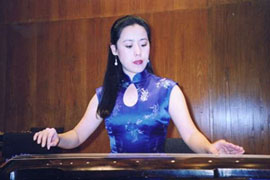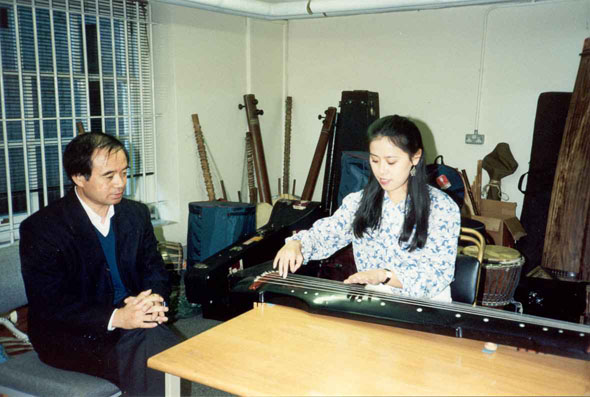Cheng Yu : Guqin
Guqin

The guqin, or qin, is an unfretted zither with 7 strings and has an unbroken history of over 2000 years. Its physical structure was already standardised by the late Han (25-220 AD), several centuries before the pipa was introduced to China. Historically, it has enjoyed the privilege of being the favourite art of the literati and the imperial aristocrats, along with Chinese chess, calligraphy and ink-painting. Such historically famous figures as Confucius of the Warring States period (475-221 BC), Ji Kang (223-265 AD) of the "Seven Sages of the Bamboo Grove", the Tang poet Bai Juyi (772-846 AD) and the Song emperor Zhao Kuangyi (976-997 AD) were all lovers and practitioners of the qin. Since the Tang (618-907 AD), collections of various qin have become popular among the privileged classes, and some valuable surviving qin from that time can still be played today.
Even more remarkable than the survival of instruments from this period is the unique notation, which is perhaps the world's oldest written solo instrumental music. The earliest surviving manuscript is the "Elegant Orchid in the Mode of Jieshi" dated 589 AD, the tablature going back to at least the 12th century. Despite the fact that the qin has the largest collection of surviving notation (over 3000 pieces) of all China's instruments, very few have been brought back to life. Furthermore, the hundreds of written works on qin theory, aesthetics, musical temperament and philosophy are highly complicated and abstruse. Though qin music has been regarded as the most sublime of China's ancient music, it is in grave decline in modern China, due largely to its traditionally esoteric place in Chinese culture and lack of support from the government. The beauty, depth and delicacy of qin music are impossible to express in words.
Performances will include a selection from the following:
- Liu Shui (Flowing Water)
- Changmen Yuan (Sorrow at Chang Men Palace)
- Meihua San Nong (Three Variations on the Plum Blossom Melody)
- Guan Shan Yue (Moon Over Guanshan)
- Yangguan San Die (Parting at Yangguan)
- Qiu Feng Ci (Autumn Wind)
- Yi Gu Ren (Memories of an Old Friend)
- Jiu Kuang (Drunken Ecstasy)
- Pu'An Zhou (Mantra of Pu'An)
- Ping Sha Luo Yan (Geese Descending on the Sandy Isle)
- Shen Ren Chang (Joy of Gods and Men)
Playing the guqin with guqin master Li Xiangting at SOAS.

